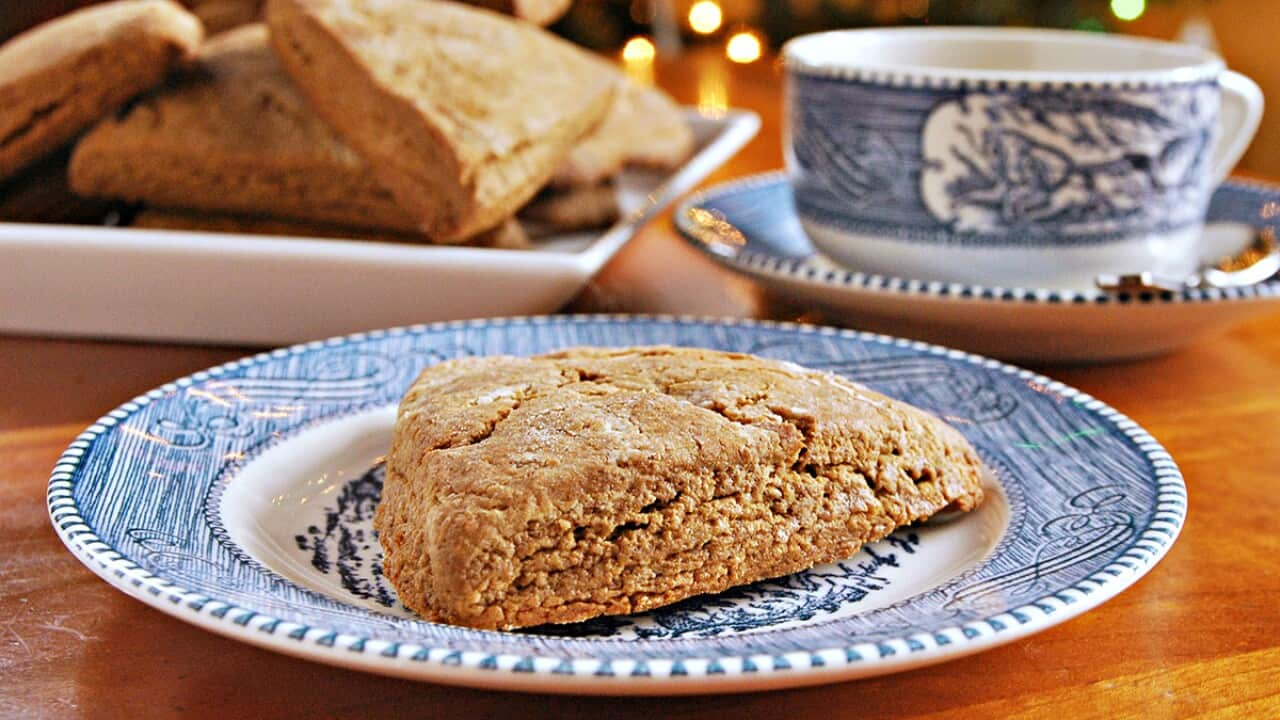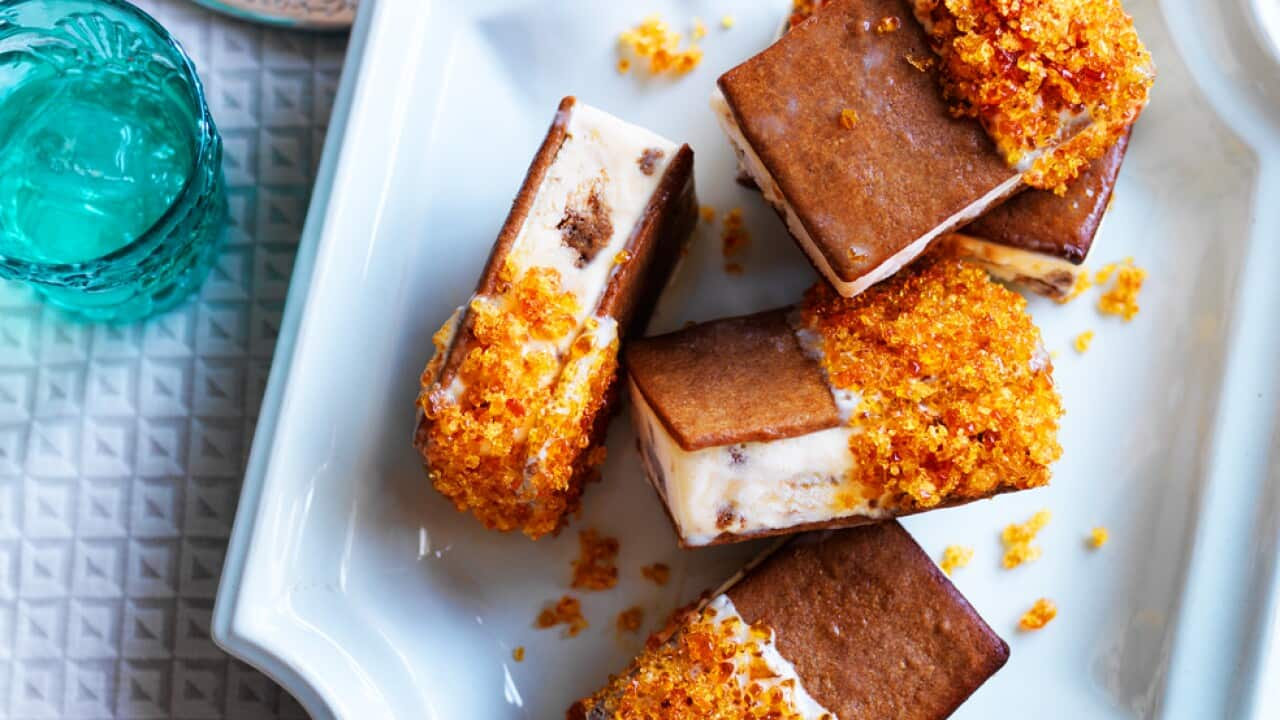Gingerbread is a very big family. It spans biscuits and cookies, decorated ‘houses’, soft cakes and sticky, dense bakes that sit somewhere between cake and slice.
“Gingerbread is, of course, not bread, but medieval recipes up to the early 18th century were certainly made with bread,” says Regula Ysewijn. The Belgian food writer has a fascinating discussion of gingerbread in her new book Oats in the North, Wheat from the South, which dives into the history of English baking.
“Breadcrumbs were heated together with honey, spices and sometimes milk or alcohol and kneaded into a dough. Often the gingerbread was coloured with powdered sandalwood, which gave it a red colour. There was also white gingerbread, made from almonds instead of breadcrumbs, which looked a bit like a spiced baked marzipan,” she writes. “Both types of gingerbread and their many varieties with different spices were often made in wooden boards carved out in the shape of animals or human figures. The early gingerbreads weren’t baked in the oven, but rather dried out from the radiant heat of an open fire and then gilded with gold leaf. In the Middle Ages, gingerbread was eaten at the end of the meal to help digestion, but it soon became a festive treat that was baked and sold on various local and religious holidays.”
Of course, the gingerbread family has branches spreading far beyond England.
“In Belgium and the Netherlands, gingerbread is known as speculaas and speculoos, but also honingkoek and peperkoek. … Germany has its variants, for example, lebkuchen, Switzerland has tirggel, among others, and the Scandinavian countries have their types of pepparkakor, brunekager and piparkakut. In Latvia, it is called piparkukas, and piparkoogid in Estonia. You’ll find mézeskálacs in Hungary, pernicky in the Czech Republic and pierniczki in Poland. Russia has prianiki and France has its pain d’épice,” she writes. “If there’s one bake that connects us all in the world, it’s gingerbread.”
Some early gingerbreads had no ginger in them – such as the ‘gyngerbrede’ in . But today, ginger is what unites the English gingerbread family, and whether you like a highly spiced crunchy biscuit, a festive or a piece of oaty parkin, there’s pretty much a gingerbread for everyone. Here in Australia, we love a good crisp gingernut biscuit (if that’s you, try Paul Hollywood’s – “It is impossible to eat just one of these deliciously moreish biscuits, as I can clearly remember from my childhood!” he says), and while we might call it a biscuit, there’s a branch of the gingerbread family populated by similar items.
Here in Australia, we love a good crisp gingernut biscuit (if that’s you, try Paul Hollywood’s – “It is impossible to eat just one of these deliciously moreish biscuits, as I can clearly remember from my childhood!” he says), and while we might call it a biscuit, there’s a branch of the gingerbread family populated by similar items. A great example of the crisp biscuit-style is from Ysewijn’s book for Cornish fairings. A ‘fairing’ is a sweet treat – often gingerbread – that was once popular at English fairs. She also shares for one of England’s best-known local variations, ®, which hails from a small village in the north of England. It is a thin but chewy biscuit, with two layers.
A great example of the crisp biscuit-style is from Ysewijn’s book for Cornish fairings. A ‘fairing’ is a sweet treat – often gingerbread – that was once popular at English fairs. She also shares for one of England’s best-known local variations, ®, which hails from a small village in the north of England. It is a thin but chewy biscuit, with two layers. The spectrum of gingerbread styles then takes a slow, spicy shift across from the crisp walls of gingerbread houses to the variously hard or tender festive biscuits, such as and and of course , and into softer creations, such as another recipe Ysewijn includes in her book for , which takes the form of small cushions. “It remains soft on the inside and is fragrant with coriander and caraway seeds,” she writes. This 18th-century recipe comes from Eliza Smith’s book, The Compleat Housewife, or, Accomplish’d Gentlewoman’s Companion from 1727. I have a delicate copy from 1737 and it is one of my most precious possessions. This gingerbread is one of my favourites from the book.”
The spectrum of gingerbread styles then takes a slow, spicy shift across from the crisp walls of gingerbread houses to the variously hard or tender festive biscuits, such as and and of course , and into softer creations, such as another recipe Ysewijn includes in her book for , which takes the form of small cushions. “It remains soft on the inside and is fragrant with coriander and caraway seeds,” she writes. This 18th-century recipe comes from Eliza Smith’s book, The Compleat Housewife, or, Accomplish’d Gentlewoman’s Companion from 1727. I have a delicate copy from 1737 and it is one of my most precious possessions. This gingerbread is one of my favourites from the book.” Ysewijn has not always loved gingerbread as much as she does now.
Ysewijn has not always loved gingerbread as much as she does now.

Source: SBS Food

Paul’s Mum’s ginger biscuits Source: Paul Hollywood's Pies and Puds

Cornish fairings Source: Murdoch Books / Regula Ysewijn

Eliza’s 18th-century gingerbread Source: Murdoch Books / Regula Ysewijn
“The first time I ate British gingerbread was when I was about 9 or 10,” she says when we chat with her about all things gingerbread. “My mum and I had bought a slab of gingerbread - the cake-like type - in the only British store we had in Flanders and when we got home we opened the sticky package in anticipation of a flavour we associate with our Belgian-style gingerbread. I remember the sensation of the first bite. It wasn’t what I was expecting because gingerbread in my country is never ginger-heavy - we call it spiced cake and it uses a lot of spices but mostly cinnamon. I remember I wasn’t keen on finishing the cake, luckily my mother did. The flavour of ginger really had to grow on me and today I do like a ginger-heavy gingerbread,” she says. (You can read more about one traditional lowland gingerbread, kruidnoten, on ).
Cake is another vital part of the gingerbread family. Usually made with treacle, golden syrup or molasses, these cakes are mostly dense and sometimes sticky. Leanne Kitchen says of her recipe for – made with black treacle or molasses – that it is best left to stand overnight before slicing, and then served with lashings of butter and extra treacle. On the other hand, this (made with ground and fresh ginger) is served as a dessert, with a lemon custard sauce.
Leanne Kitchen says of her recipe for – made with black treacle or molasses – that it is best left to stand overnight before slicing, and then served with lashings of butter and extra treacle. On the other hand, this (made with ground and fresh ginger) is served as a dessert, with a lemon custard sauce.

Dark gingerbread cake Source: Chris Chen
Parkin is a sticky ginger cake or slab, usually made with oats or oat flour. The more common, cake-like version is often associated with Guy Fawkes Night, an English tradition also known as Bonfire Night that marks the failure of a plot in 1605 to blow up the House of Lords. There’s also a biscuit-like variation found to the north and in Scotland.
Give it a go with : “It’s a brilliant sweet to make ahead as it only becomes more delicious after a couple of days when the flavours intensify even further,” he says. Parkin is often made with lard, but if you’d prefer a butter-only version, try from Anneka Manning, which becomes slightly softer and stickier after a day or two. “You’ll find it is slightly addictive and great with a cuppa, particularly through the winter months,” she says. Regula Ysewijn has a parkin recipe too, . And sitting right on the edge of gingerbread-meets-cake are recipes like unashamedly spicy cake, a loaf made with ground ginger and preserved ginger, and allspice too.
And sitting right on the edge of gingerbread-meets-cake are recipes like unashamedly spicy cake, a loaf made with ground ginger and preserved ginger, and allspice too. There's a lot of branches on the gingerbread family tree. If you had to choose, we asked Ysewijn, which would it be: cake-like gingerbread, chewy biscuit gingerbread, or hard ginger biscuit?
There's a lot of branches on the gingerbread family tree. If you had to choose, we asked Ysewijn, which would it be: cake-like gingerbread, chewy biscuit gingerbread, or hard ginger biscuit?

Regula Ysewijn's parkin Source: Regula Ysewijn

Stem ginger loaf with vanilla frosting Source: Tribune News Service
“Gosh, that is a difficult question! I suppose it depends on the occasion. They are all so very different and on some days, I crave a snappy biscuit, on others a moreish dark ginger cake.”
We, too, could never narrow it down to one ‘best gingerbread’ - find your favourite in our gingerbread , which includes everything from to .









